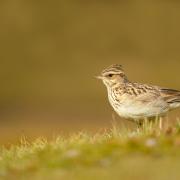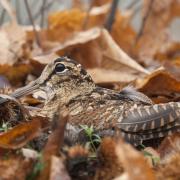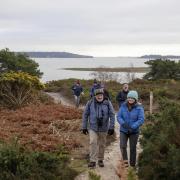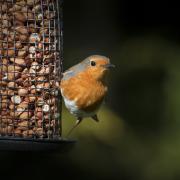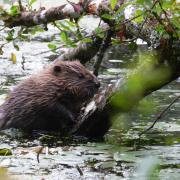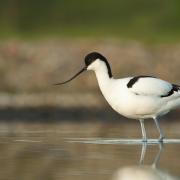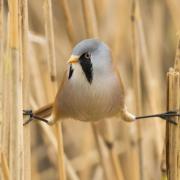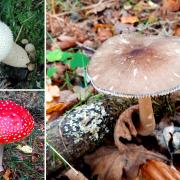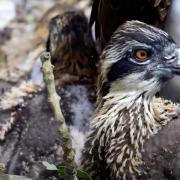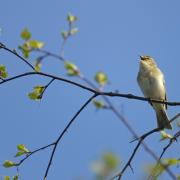A flock of ground-breaking projects to reintroduce ‘lost’ native species such as white stork, osprey and white-tailed eagle could offer some exciting eco-tourism opportunities for South Dorset, says Paul Morton of the charity Birds of Poole Harbour.
A series of inspiring environmental initiatives happening across England’s South Coast could provide multiple eco-tourism opportunities for the Bournemouth, Christchurch, Poole and Purbeck area over the coming years. The last 18 months has seen a huge spike in the number of people wishing to not only connect with nature, but to learn about its functionality and backstory too. Too often, social media and news channels highlight the most catastrophic environmental stories from across the globe, but, here in Dorset (and along the South Coast) a new era of positive environmental change is emerging, focussing on nature recovery with several high-profile projects aiming to restore lost habitats and species.

Last February saw the launch of the ground-breaking Purbeck Heaths National Nature Reserve, the UK’s first ‘super’ NNR, and connecting 11 different kinds of habitat. A joint partnership project between Amphibian and Reptile Conservation Trust, Dorset Wildlife Trust, Forestry England, National Trust, Natural England, the Rempstone Estate and the RSPB, it spans 8,231 acres: from Grange Heath in the west to Studland in the east and from the Arne peninsula in the north to Norden in the south, enveloping three existing NNRs at Hartland Moor, Stoborough Heath, Studland and Godlingston Heath as well as new land. This makes it the largest area of lowland heath managed as a single nature reserve in England. What a wonderful collaboration!
This year, Dorset Wildlife Trust obtained a 170-hectare area of land south-east of Bere Regis – renamed Wild Woodbury - which will focus on rewilding the previously farmed area. In addition, the National Trust currently have a licence application underway to undertake a wild beaver reintroduction in the Little Sea area of Studland, this once native mammal is a dynamic eco-engineer whose introduction vastly improves habitats and reduces flood risks. Collectively, all these projects place South Dorset in a unique position to not only improve and accelerate species and ecosystem recovery, but to also attract and establish a growing eco-tourism audience.
Then there are the birds. Four years ago, we started the Birds of Poole Harbour Osprey Translocation Project in an effort to restore a breeding osprey population. This summer we saw a pair form and witnessed the male displaying high over his nest site: a behaviour that’s not been seen in southern Britain for two centuries. Although they didn’t breed this time, the signs are that this is the beginnings of re-colonisation.

It’s been brilliant to see this success, but it was a series of extraordinary events in September that really blew my mind. Firstly, on September 16 we saw an incredible sight, possibly for the first time in 400 years - 36 white storks flying over the harbour during their migration. These were from the white stork reintroduction in Sussex and Surrey run by the Roy Dennis Wildlife Foundation, Cotswold Wildlife Park, Durrell Wildlife Conservation Trust, and Warsaw Zoo.

The following day, one of the Isle of Wight white-tailed sea eagles (from a project run by the Roy Dennis Wildlife Foundation and Forestry England) paid us a visit. After hanging out at the lagoon on Brownsea Island, it relocated to Middlebere near RSPB Arne where people were treated to the sight of this majestic bird of prey with its 8ft wingspan, soaring overhead before it headed off north on its migration.

If anyone had said to me ten years ago that in the space of a week, we’d see displaying osprey, migrating white storks and a white-tailed sea eagle in Poole Harbour I would have laughed in disbelief. Yet here we are, a decade later, with the real possibility that these birds will soon become a regular sight, having been missing from our landscape for centuries. It is a dream come true.
To give you an idea of the economic impact this can have - on the Isle of Mull in Scotland, where white-tailed sea eagles were reintroduced in 1975, it’s now estimated that tourism associated with sea eagles brings in around £5 million to the local economy. So, imagine the economic potential when sea eagles first nest along the South Coast!

The increasing interest in birdwatching, from both locals and visitors, has been encouraging too. In 2017, when Birds of Poole Harbour began their Osprey Translocation Project, we hosted a single boat trip to show and talk to people about the project. Due to demand, we had to put on two more trips. In 2018 it rose to eight, in 2019 ten and in 2021 the charity hosted 15 (sold out) birdwatching cruises, with people from Dorset and beyond wanting to learn about osprey conservation and see these magnificent birds. Poole Harbour’s osprey nest-cam now has a global audience of many thousands, thanks to last year’s lockdown which saw people accessing wildlife webcams from their laptops.
It’s not just conservation NGO’s that are doing their bit, the councils have been enhancing and improving eco-systems through initiatives such as the wild verges scheme to help create wildlife corridors. Although this can sometimes seem contentious, it’s this kind of progressive thinking adopted by councils that fits into the much bigger picture of what’s happening locally.
I’ve lived in the Poole Harbour area all my life, and never have I been so excited and optimistic about this location’s future. Everyone should take great pride in what’s happening locally, embrace it, immerse yourself in it and ensure we carry on with this trajectory.
Many areas across the UK would be begging to have just one of these amazing projects on their doorsteps to benefit from. The fact that here in South Dorset we have six or seven happening now, says to me that we’ve now got a brilliant opportunity to make great strides both environmentally and economically.

Conservationists hope that with the recovery and enhancement of ecosystems and large tracts of land across the South Coast, as well as the recovery of keystone species such as sea eagles, beavers and ospreys, we will all get to benefit from this exciting new environmental dynamic. It could even herald the beginning of an eco-tourism boom, right here in Dorset.
Find out more at birdsofpooleharbour.co.uk or visit them in their temporary winter roost at Poole Museum.









